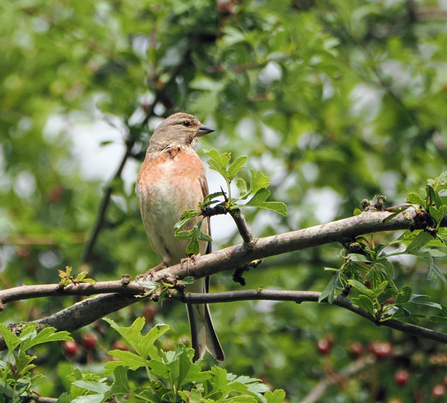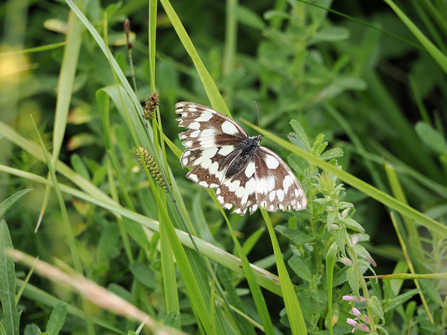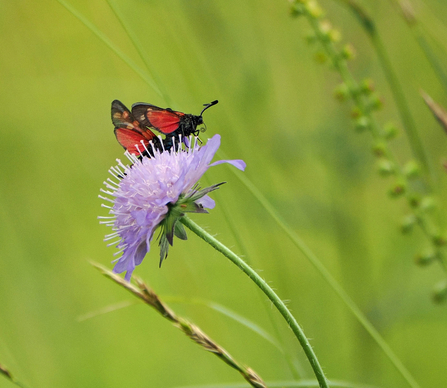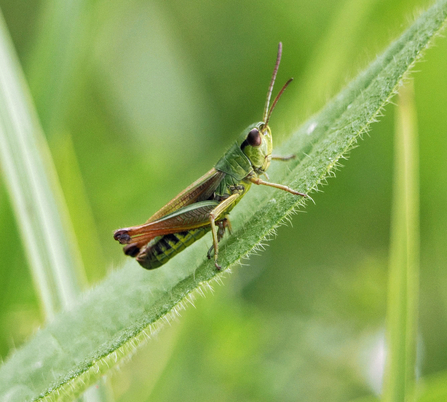The latest thing to stop me in my tracks is a burst of trilling, melodic birdsong. It’s coming from somewhere in the mature hedgerow on my left – the sort of messy, dense tangle of trees, shrubs, thorns, fruit and flowers that nature loves.
Magnesian meadows and marbled marvels: a visit to Ledsham Bank
(C) Rod Jones

Male linnet (C) Rod Jones
I soon spot the songsters – two male linnets perching in a hawthorn tree. It’s a rare treat for me to watch these handsome finches with their rosy-coloured chests: the UK population of linnets dropped by 57% between 1970 and 2014, and I hardly ever see them in my home patch in Pennine West Yorkshire.
They may be much more common, but I did appreciate the robin clinging to a stalk and having a good look at me the moment I entered the reserve, and the dunnock doing the same a few minutes later. I’ve also seen a red kite circling high overhead and heard the laughing call of a green woodpecker. There are plenty of butterflies too: I’ve already photographed speckled wood, green-veined white, gatekeeper and meadow brown by the time I’m distracted by the linnets.
I must admit I was slightly dubious before I visited Ledsham Bank. On paper it looked disappointingly small (Potteric Carr, at 200 hectares, is 40 times as big). It’s also far from remote: from the top end of the reserve, you can see trucks thundering past near the busy Selby Fork junction of the A1(M) and A63. But I soon discover that Ledsham Bank’s rare geology makes it a wonderful place for nature: it’s a Site of Special Scientific Interest as one of the last untouched magnesian limestone grasslands.
Chiffchaff (C) Rod Jones
Reflecting on how wrong preconceptions can be, I walk on – only to be sidetracked almost immediately by another photogenic bird. This time it’s a chiffchaff, a tiny leaf warbler, flitting around in the hedgerow among some green elderberries.
As the path drops down into the meadow, the full summer glory of Ledsham Bank’s wildflowers is revealed. My knowledge of plants and flowers is pretty limited, and I use the Seek app on my phone to identify a couple of species that grab my attention: field scabious (a gorgeous, lilac-coloured flower that’s a magnet for bees and butterflies) and common agrimony (the delicate yellow flower providing a platform for the metallic blue and green beauty of a banded demoiselle damselfly in the photo at the top of this article).
Like most photographers, I’m keen to get as close as possible to my subject, but Yorkshire Wildlife Trust asks visitors not to stray off the footpath that loops round Ledsham Bank. That’s because trampling feet could damage one of the reserve’s real gems – it’s the most northerly place you can find the extremely rare pasqueflower, which blooms at Easter time. So I stick to the path and use my telephoto lens to try to bring my subjects nearer.

Marbled white butterfly (C) Rod Jones
If there’s one thing I’m desperate to see while I’m here, it’s a marbled white butterfly. This spectacular species, much commoner in southern and central England, has gradually moved north into Yorkshire over the past couple of decades. I caught a glimpse of one last summer at Yorkshire Wildlife Trust’s Ledston Luck reserve, a couple of miles from Ledsham Bank, but I’ve never managed to photograph one…until today.
I spot two of them, fluttering around among the long grasses and flowers near the path. To be honest, they’re maybe a little tatty and faded to brown and white, rather than the strikingly contrasting black and white marbled appearance of those in pristine condition, but I’m really not bothered: it’s another wonderful wildlife sighting at this little nature oasis.
Essex skipper butterfly (C) Rod Jones
As the day heats up, more butterflies dance among the wildflowers, including lots of tiny, fast-moving orange ones. I photograph one with huge eyes and a furry body, assuming it’s a small skipper.
When I get home, I check the photo on my Seek app, which identifies it as an Essex skipper (characterised by the black tips of its antennae) – another species I haven’t knowingly photographed before.

Six-spot burnet moths mating (C) Rod Jones
It’s warm and sunny, but the wind’s picking up, causing the flowers to sway about, making it tricky for the insects trying to cling to them…and the photographer trying to get them in focus. Six-spot burnets – vivid red and black moths – are everywhere. I even spot two mating on a field scabious flower as it pitches about alarmingly like a small boat in a storm.
There are plenty more birds to see too: a squadron of 20 or 30 swallows hunting insects in the skies above the far end of the reserve; a buzzard mewing as it flaps out of the wood next to the site; a baby wren bursting out of the undergrowth.

Meadow grasshopper (C) Rod Jones
As I watch grasshoppers bounding about in the long grass, I think what a fantastic place this would be for children who are interested in nature. They’d need to stick to the path, of course, but it’s only a short walk for little legs - and sharp eyes, closer to the ground, would spot plenty of wonders missed by adults.
I finally leave Ledsham Bank after five hours, during which time I’ve only met one other person on the reserve. Admittedly, when it comes to watching and photographing wildlife, I’m an Olympic-standard dawdler. But why rush when there are so many fascinating things to see?
*For more details about visiting Ledsham Bank, see https://www.ywt.org.uk/nature-reserves/ledsham-bank-nature-reserve

